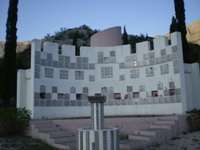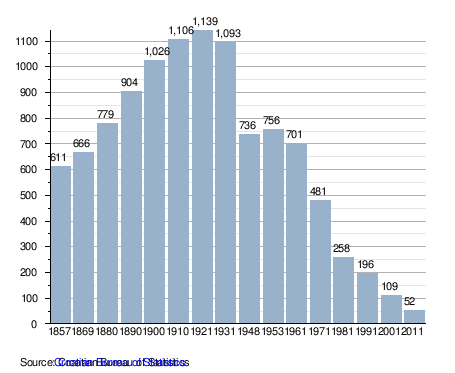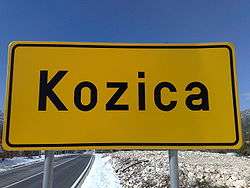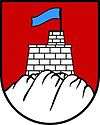Kozica, Croatia
| Kozica | |||
|---|---|---|---|
| Village | |||
|
A sign at the entrance to Kozica | |||
| |||
 Kozica | |||
| Coordinates: 43°15′42″N 17°13′01″E / 43.261691°N 17.217076°ECoordinates: 43°15′42″N 17°13′01″E / 43.261691°N 17.217076°E | |||
| Elevation | 350 m (1,150 ft) | ||
| Population (2011)[1] | |||
| • Total | 56 | ||
| Time zone | CET (UTC+1) | ||
| • Summer (DST) | CEST (UTC+2) | ||
| Postal Code | 21274 | ||
| Area code | 021 | ||
| Licence plate | MA | ||
| Climate | Cfa | ||
Kozica (Italian: Cozizza) is a small village in the Split-Dalmatia County of Croatia. It is in the jurisdiction of Vrgorac, 80 km (50 mi) southeast of Split. It lies just below Sveti Mihovil mountain, which is 1,247 m (4,091 ft) high.
History
Kozica was first mentioned in documents of the Kreševskoj era in 1434.
Ottoman Empire
When Vrgorac capitulated to the Ottoman Empire, Kozica probably fell with the rest of the area. The spread of Islam into the region that came with the arrival of the Ottoman army concerned the occupants of the monastery in Makarska, who began to worry about the residents in Kozica and the surrounding region, fearing that many would convert to Islam.
Post-Ottoman occupation
After the liberation of inner Dalmatia from the Ottoman Empire, most of Kozica and the surrounding villages had been deserted because of the exodus of the populace to the northern regions of Croatia. The Venetian Republic repopulated the area with Herzegovinian people from the east.
The withdrawal of the Ottomans saw the region come under the jurisdiction of the Venetian Republic, then under the rule of Napoleon. A short and prosperous period followed, which included the construction of the "napoleonsku cestu" (Napoleon's road), encouraging travel to the area. With the failure of Napoleon's campaign in Dalmatia, Kozica fell under the rule of Austria-Hungary, and remained so until the end of the First World War.
Kingdom of Serbs, Croats and Slovenes (1918–1941)
Many of Kozica's population bought land near Vrgorac, where they grew their own produce, including olives and grapes; the area acquired a reputation for good wine. The Second World War changed this for the worse.
World War II
Hitler occupied Yugoslavia from April 1941; he carved the country up using different Axis armies. Kozica and the surrounding region was occupied by the Italians. With their forces operating a garrison in Kozica, it was able to keep the village and surroundings under observation. However, a rapidly growing force, Tito's partisans, was operating in the area.
Kozica became known as a partisan village as many opposed Hitler's ideology and the presence of foreign forces on their land. Jozo Jurcevic's partisan brigade, led by Petar Bogunović, numbered about 350 men from the Pelješac peninsula and southern Dalmatia. It was active in the Biokovo area from June 6, 1942. Kozica was a starting point which to launch their offensives to free the city of Vrgorac from Nazi occupation. The Italians became infuriated and decided to take action. Operation Albia gave the Italian army the objective of wiping out all partisans from Biokovo, this caused great harm to the civilians in the area.

In August 1942, the Italian army brought Četnik forces to the area in trucks; their mission was to destroy everything and "clean" Biokovo of partisans, disregarding NDH wishes to keep Četniks out of Croatia. This action brought controversy to the region, implying the Italians were only looking after their interests. On 29 August, the Četniks rounded up all the people in the villages, put them in a house and set it on fire, killing 270 civilians, 66 of them from Kozica. After the Četnik rampage, nearly all of Kozica's infrastructure and housing was destroyed. Following the Italian surrender to the Allies, the incoming Germans and Ustase (a Croatian pro-nazi movement), launched their sixth anti-Partisan Offensive (Šesta neprijateljska ofenziva/ofanziva). Kozica was reoccupied along with the rest of the Vrgorac municipality only for the Germans to retreat in October 1944. A common saying in Kozica has come about due to the Human losses in World War 2, "Kozica selo malo, puno partizana je dalo" (Kozica is a little village yet it produced many Partisans)
Climate
Kozica has a Sub-Mediterranean climate, but due to its elevation Kozica has its own microclimate which differs from the Dalmatian Coast. Kozica is situated on a plateau in between two mountains, Biokovo and Sveti Mihovil.
Tourism and the economy
Tourism has started in Kozica and it is becoming popular for cyclists who tour the region and its rocky landscape. Kozica's natural beauty is also an attraction in the summer. Kozica is a small Mediterranean mountain village which is 20 minutes by car from the nearest beach. Kozica is also home to various palm trees and many other types of flora. Kozica's landscape is a mixture of natural and man-made structures. Tourism in Kozica is expected to increase with the construction of the A1 highway from Zagreb via Split to Dubrovnik. The nearest motorway exit for Kozica is Ravča which is 3–4 km (1.9–2.5 mi) south of Kozica.
Demographics
History of the number of inhabitants

[2] There was an increase in population from the 1800s until the Second World War. After 1945 the decrease in population was due to the exodus of people trying to find a better life in the cities or migrating. In recent times, there was a dramatic drop from previous censa.
Gallery
 Kozica from Biokovo
Kozica from Biokovo A postcard of Kozica believed to be from 1900
A postcard of Kozica believed to be from 1900 Kozica, a view from the north
Kozica, a view from the north
References
- ↑ "Population by Age and Sex, by Settlements, 2011 Census: Kozica". Census of Population, Households and Dwellings 2011. Zagreb: Croatian Bureau of Statistics. December 2012.
- ↑ http://www.dzs.hr/Hrv/pxweb2003/Dialog/varval.asp?ma=Tabela4_17&ti=Splitsko-dalmatinska+%9Eupanija+-+broj+stanovnika+po+naseljima+&path=../Database/Naselja%20i%20stanovnistvo%20Republike%20Hrvatske/4%20Stanovnistvo%20naselja/&lang=10
External links
| Wikimedia Commons has media related to Kozica. |


